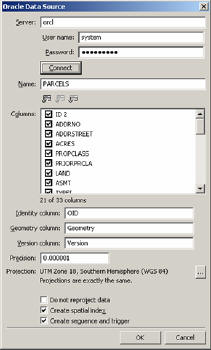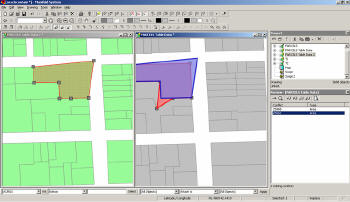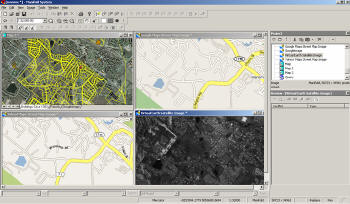Vendor
Manifold Net Ltd.
1945 North Carson Street
Suite 700
Carson City, NV 89701
1-800-556-5919
www.manifold.net
Price $245
Introduction
In 2005, Paul Amos provided an overview of Manifold GIS. He indicated that there had been three major releases of Manifold GIS since his last review in 2002. Similarly, since the 2005 review, there have been two more major releases of Manifold, with a combined total of more than 800 new features (new functions and bug fixes).
The most recent release began as Release 6.5 SP1, but with all the major innovations introduced, it warranted its own release number and became Manifold 7.00. For existing Manifold 6.5 users, this new release will constitute a free upgrade of the product. As a beta-tester of the product, I want to share these highlights:
- More than 500 improvements
- Dynamic integration of Google Maps, Yahoo! Maps and Microsoft’s Virtual Earth into the desktop application.
- A DVD that includes the Digital Chart of the World, Manifold World, 3D View Studio, and Database commander. Those products were offered for separate purchase in the past.
- Full enterprise GIS integration with Oracle Spatial, in addition to the ability to store geometry in IBM’s DB2 and Microsoft’s SQLServer.
With over 300 new features specific to this release, it’s hard to pinpoint just a few. However, when beta-testing the product, I found a few categories of newly introduced innovations that I particularly liked.
Pushing the Enterprise Envelope
Manifold Enterprise edition ($395) supports enterprise databases, and Oracle, IBM, and Microsoft provide free versions of their databases on the DVD. For those who really want to push the envelope with interoperable databases, with this release Manifold can simultaneously access all three databases from a single application, allowing users to copy and paste data from Oracle Spatial into OGC WKB for storage in SQL Server or DB2!
Manifold integrates GIS with Oracle Spatial. The Manifold interface makes uploading spatial data to Oracle as easy as right-clicking on a data component and selecting “Export to Oracle Spatial.” The Oracle Spatial integration allows storage of both vector and raster components in Oracle for access by Manifold. In addition, storing data in Oracle Spatial allows Manifold users to work with terabyte size drawings and images. The Oracle Spatial integration also works with “area-of-interest” windows that allow a user to check-out and edit only a portion of a terabyte sized drawing.
Until this release, linked data were only available in read-only format. With 7.00, users can now modify geometry and attribute data stored in these other databases, applications and file formats. For example, users can make geometric changes to the data that are stored in Access or Excel. With the exception of the Oracle spatial integration, this is probably my favorite feature as I often desire to leave data in other applications (like Access or Excel), but still want to make changes to the data based on some geospatial analysis I'm performing.
Internet Integration
Previous standard editions of Manifold GIS included an Internet Map Server (IMS) application within the product. Manifold 7.00 Personal Edition ($245) will not include the IMS product, while all the other editions will.
Manifold now allows integration with Google Maps, Yahoo! Maps, and Microsoft’s Virtual Earth. Both imagery and street maps from Google and Virtual Earth can now be linked to Manifold projects and used as background imagery for a user’s GIS. You can also download the Google Map image for your geographic area onto your hard drive for permanent use, although be prepared to wait awhile depending upon the speed of your Internet connection – it’s a lot of image data! This was probably the favorite feature for most of my students who often need a good image basemap for some of the remote areas where they are performing their research.
Import and Export
Manifold 7.00 includes numerous new import and export capabilities including: export to Google’s KML file; import data directly from ARC/INFO coverages and TINs.
Manifold 7.00 supports image libraries. Users can automatically tile mosaics of separate images with automatic geo-registration from numerous formats, including ECW and GeoTIFF. It’s also possible to create an index drawing of the images that can be used to reference the individual images.
New Analytical Functions
The query engine now supports latitude and longitude data types, and new spatial SQL constructs allow users to compute ellipsoidal areas and perimeters of objects stored in latitude and longitude. This is especially important for international work. Most of the topological processing functions are speedier and can handle larger data sets.
License Server Activation
Manifold 7.00 has new license management for large enterprise environments. There is no need for serial numbers and activation keys on each machine.
I think existing users will find this release well worth the wait, and newer users will enjoy working with a GIS application that includes so many leading edge innovations. A longer version of this review, highlighting several additional items, is available.


